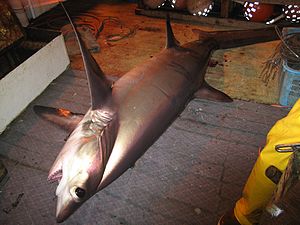Bigeye thresher shark
| Bigeye thresher shark | ||||||||||||
|---|---|---|---|---|---|---|---|---|---|---|---|---|

Bigeye thresher shark ( Alopias superciliosus ) |
||||||||||||
| Systematics | ||||||||||||
|
||||||||||||
| Scientific name | ||||||||||||
| Alopias superciliosus | ||||||||||||
| Lowe , 1839 |
The bigeye thresher ( Alopias superciliosus ) is one of three species of fox sharks (Alopiidae). It is common in large parts of the entire subtropical and tropical areas of the world's oceans.
Appearance and characteristics
The bigeye thresher is a large shark with an average body length of 300 to 400 cm, the maximum length can reach up to 460 cm with a weight of around 160 kg. It has a dark blue to blue-violet color on the back without any noticeable markings and a white color on the abdomen.
The shark has a conical rounded snout and, compared to other thresher sharks, very large and upward-pointing eyes. The caudal fin is very large and the upper caudal lobe has a length that almost corresponds to that of the rest of the body. It has a very small anal fin and two dorsal fins . The first dorsal fin is significantly larger than the second, which, like the anal fin, is only very small, and lies behind the pectoral fins. The pectoral fins are relatively large and do not end pointy as in the common thresher shark ( A. vulpinus ). Like all species of the genus, the animals have five gill slits and no injection hole .
Way of life
The bigeye thresher is a deep sea species, but can also appear regularly near the coast. It lives in water depths from the sea surface up to a depth of 500 m, whereby the upward-pointing eyes indicate a regular stay in deeper water areas. Because the body temperature is higher than that of the environment, the shark can swim very effectively even in cold waters. He predatory feeds on various bony fish , where he drives them together in shoals with the help of his long tail and then kills or stuns them with this before he eats them.
Reproduction
Like other species of mackerel shark, it is viviparous and does not form a placenta ( aplacental viviparous ). The females usually get 2 young animals per litter, uterine cannibalism is present. The young sharks are less than 100 centimeters in size and grow relatively quickly. The animals reach sexual maturity at a length of approximately 270 to 300 cm.
distribution
The bigeye thresher shark is common in large parts of the entire subtropical and tropical areas of the world's oceans. Its main distribution is in the high seas.
literature
- Leonard Compagno , Marc Dando, Sarah Fowler: Sharks of the World . Princeton University Press , Princeton and Oxford 2005, ISBN 978-0-691-12072-0 , p. 179.
Web links
- Species portrait on hai.ch
- Bigeye thresher on Fishbase.org (English)
- Alopias superciliosus inthe IUCN 2013 Red List of Endangered Species . Posted by: Amorim, A., Baum, J., Cailliet, GM, Clò, S., Clarke, SC, Fergusson, I., Gonzalez, M., Macias, D., Mancini, P., Mancusi, C. , Myers, R., Reardon, M., Trejo, T., Vacchi, M. & Valenti, SV, 2007. Retrieved November 6, 2013.
